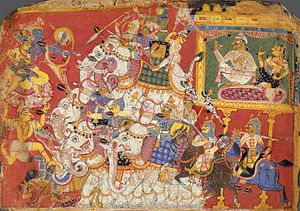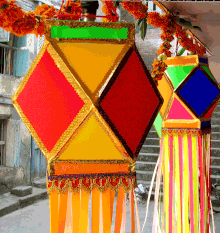This year 2010 the Diwali dates are as follows :
3.11.10 ----> VasuBaras, Dhanatrayodashi , Dhanwantri Jayanti
5.11.10 ---> DIWALI, Lakshmi Puja & Narak Chaturdashi
6.11.10----> Amawasya
7.11.10----> Bali Pratipada & Bhaiduj / Bhaubeej
Vasubaras - Vasu Baras (27 Ashvin or 12 Krishna Paksha Ashvin): Baras means the 12th day and vasu means cow. On this day the cow and calf are worshiped.
Vasubaras - Vasu Baras (27 Ashvin or 12 Krishna Paksha Ashvin): Baras means the 12th day and vasu means cow. On this day the cow and calf are worshiped.
-----------------------------------------------------------------------------------------------------------------------------------
Information below is from Wiki for more information go to : http://en.wikipedia.org/wiki/Diwali
Deepavali is celebrated for five days according to the lunisolar Hindu Calendar. It begins in late Ashvin (between September and October) and ends in early Kartika (between October and November). The first day is Dhan Teras. The last day is Yama Dvitiya, which signifies the second day of the light half of Kartika. Each day of Deepavali marks one celebration of the six principal stories associated with the festival.[6].
Hindus have several significant events associated with Diwali:
- The return of Sri Ram after 14 years of Vanvas (banishment). To welcome his return, candles were lit in rows of 20.
- The killing of Narakasura: Celebrated as Naraka Chaturdashi, one day before Deepavali, it commemorates the killing of the evil demon Narakasura, who wrecked havoc. Krishna's wife Satyabhama killed Narakasura during the Dwapara yuga. In another version of the belief, the demon was killed by Krishna or Krishna provoked his wife Satyabhama to kill Narshna, defeating Indra.
- Govardhan Puja is celebrated the day after Deepavali and is the day Krishna defeated Indra, the deity of thunder and rain. According to the story, Krishna saw preparations for an annual offering to Lord Indra and asked his father Nanda about it. He debated with the villagers about what their 'dharma' truly was. They were farmers, they should do their duty and concentrate on farming and protection of their cattle. He said that all human beings should do their 'karma' to the best of their ability and not pray for natural phenomenon. The villagers were convinced by Krishna, and did not proceed with the special puja (prayer). Indra was then angered, and flooded the village. Krishna lifted Mount Govardhan and held to protect the people and cattle from the rain. Indra finally accepted defeat and recognized Krishna as supreme. Although this aspect of Krishna's life is sometimes ignored[citation needed] it sets up the basis of the 'karma' philosophy later detailed in the Bhagavat Gita.
- Vasu Baras (27 Ashvin or 12 Krishna Paksha Ashvin): Baras means the 12th day and vasu means cow. On this day the cow and calf are worshiped.
- Dhanatrayodashi or Dhan teras or Dhanwantari Triodasi'[8] (8 Ashvin or 13 Krishna Paksha Ashvin): Dhan means wealth and Trayodashimeans 13th day. This day falls on the 13th day of the second half of the lunar month. It is considered an auspicious day for buying utensils and gold. This day is regarded as the Jayanti of God Dhanvantri who came out during the churning of the great ocean by the gods and the demons.
- Naraka Chaturdashi (29 Ashvin or 14 Krishna Paksha Ashvin): Chaturdashi is the 14th day on which the demon Narakasura was killed by Krishna – an incarnation of Vishnu. It signifies the victory of good over evil and light over darkness (Gujarati: Kali Chaudas, Rajasthan : Roop Chaudas). In south India, this is the actual day of festivities. Hindus wake up before dawn, have a fragrant oil bath and dress in new clothes. They light small lamps all around the house and draw elaborate kolams /rangolis outside their homes. They perform a special puja with offerings to Krishna or Vishnu, as he liberated the world from the demon Narakasura on this day. It is believed that taking a bath before sunrise, when the stars are still visible in the sky is equivalent to taking a bath in the holy Ganges. After the puja, children burst firecrackers heralding the defeat of the demon. As this is a day of rejoicing, many will have very elaborate breakfasts and lunches and meet family and friends.
- Lakshmi Puja (30 Ashvin or 15 Krishna Paksha Ashvin): Lakshmi Puja marks the most important day of Diwali celebrations in North India. Hindu homes worship Lakshmi, the goddess of wealth, and Ganesh, the God of auspicious beginnings, and then light lamps in the streets and homes to welcome prosperity and well-being.
- Bali Pratipada and Govardhan Puja (1 Kartika or 1 Shukla Paksha Kartika) : In North India, this day is celebrated as Govardhan Puja, also called Annakut, and is celebrated as the day Krishna – an incarnation of god Vishnu – defeated Indra and by the lifting ofGovardhana hill to save his kinsmen and cattle from rain and floods. For Annakut, large quantities of food are decorated symbolizing the Govardhan hill lifted by Krishna. In Maharashtra, Tamil Nadu and Karnataka, it is celebrated as Bali-Pratipada or Bali Padyami. The day commemorates the victory of Vishnu in his dwarf form Vamana over the demon-king Bali, who was pushed to the nether-world, and the return of Bali to earth from the nether-world. In Maharashtra, it is called as Padava or Nava Diwas (new day). Men present gifts to their wives on this day. It is celebrated as the first day of the Vikram Samvat calender, in Gujarat.
- Bhaiduj (also Bhayyaduj, Bhaubeej or Bhayitika) (2 Kartika or 2 Shukla Paksha Kartika): on this day, brothers and sisters meet to express love and affection for each other (Gujarati: Bhai Bij, Bengali: Bhai Phota). It is based on a story when Yama, lord of Death, visited his sister Yami. Yami welcomed Yama with an Aarti and they had a feast together. Yama gave a gift to Yami while leaving as a token of his appreciation. So, the day is also called 'YAM DWITIYA'.



No comments:
Post a Comment